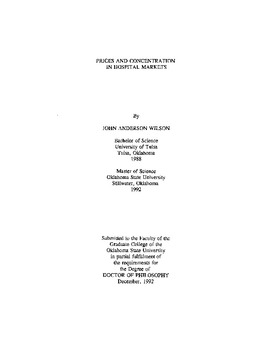| dc.contributor.author | Wilson, John Anderson | |
| dc.date.accessioned | 2015-09-17T17:45:59Z | |
| dc.date.available | 2015-09-17T17:45:59Z | |
| dc.date.issued | 1992-12 | |
| dc.identifier.uri | https://hdl.handle.net/11244/18452 | |
| dc.description.abstract | Scope and Method of Study: The main purpose of this study was to determine how hospital markets react to competition. On the one hand, competition may tend to improve the welfare of society by reducing hospital charges to marginal cost. On the other hand, competition may drive up hospital charges due to several unusual characteristics about hospital markets. For instance, in most situations insurance pays a large portion of the patients' bill, making the consumer of health care insensitive to the level of price, but sensitive to the level of quality. Therefore hospitals in more competitive markets may drive up hospital costs and hospital charges by attempting to improve the level of quality. In addition, most hospitals are non-profit hospitals. Maw Lin Lee hypothesized that nonprofit hospital managers attempt to maximize their utility functions by improving the status of their hospitals. To improve the status of their hospitals, the non-profit hospital managers increase the costs of the hospital by purchasing expensive equipment or improving the surroundings of the hospital. The end result is that competition among non-profit hospitals increases costs and charges. A price-concentration study was performed to determine whether competition tends to increase or reduce hospital charges. | |
| dc.description.abstract | Findings and Conclusions: This study showed that for-profit hospitals in more competitive markets charged lower prices than for-profit hospitals in less competitive markets. In addition, it was found that non-profit hospitals react to competition in two different ways. When patients have the ability to determine the level of price and quality that they desire, there was a tendency for there to be a positive relationship between hospital charges and market concentration. However, when the patients do not have time to determine information about hospitals, there was a tendency for non-profit hospitals to charge higher prices in more competitive markets. The fact that this negative relationship between price and concentration was only observed with non-profit hospitals tends to support Maw Lin Lee's hypothesis. | |
| dc.format | application/pdf | |
| dc.language | en_US | |
| dc.rights | Copyright is held by the author who has granted the Oklahoma State University Library the non-exclusive right to share this material in its institutional repository. Contact Digital Library Services at lib-dls@okstate.edu or 405-744-9161 for the permission policy on the use, reproduction or distribution of this material. | |
| dc.title | Prices and concentration in hospital markets | |
| osu.filename | Thesis-1992D-W749p.pdf | |
| osu.accesstype | Open Access | |
| dc.type.genre | Dissertation | |
| dc.type.material | Text | |
| thesis.degree.discipline | Economics | |
| thesis.degree.grantor | Oklahoma State University | |
